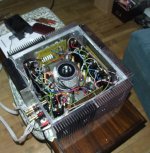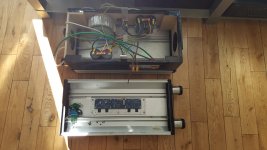What should change if I want to increase the number of output devices to say 4 or 5 pairs? I have really inefficient (86dB/1W/1m) 4R speakers. I could bridge two channels for a total of 12 output devices, but my case won't be able to handle the heat of a stereo amp (and I don't have the budget for monoblocks) . I have a modushop 5U 400 chassis. Would the jfet input buffer of a single channel be able to drive 4 or 5 pairs of output devices? Thanks
Thanks ZM - I was actually thinking of more output devices at the recommended bias settings (ie. higher sum Iq) for more heat and more overall power. My modushop 5U 400 chassis should be able to dissipate 270-300W of heat, which should work for 5 pairs of output devices but may not be enough to fully duplicate each channel. Any idea why for higher power, Papa Nelson recommends a parallel mono arrangement (so parallel input buffers and 6 output pairs) rather than simply adding extra output devices (as for the ba-2)?
Thanks ZM - I was actually thinking of more output devices at the recommended bias settings (ie. higher sum Iq) for more heat and more overall power. My modushop 5U 400 chassis should be able to dissipate 270-300W of heat, which should work for 5 pairs of output devices but may not be enough to fully duplicate each channel. Any idea why for higher power, Papa Nelson recommends a parallel mono arrangement (so parallel input buffers and 6 output pairs) rather than simply adding extra output devices (as for the ba-2)?
you can go up with Iq per device, up to 35W (for 240/9240), if you keep them cool
that's way more than heatsink of 5U/400 can cope with
as Jim sez, - crank it, keeping a palm on heatsink
I've got both here, an Aleph 4 and an Aleph J, they are both really impressive amplifiers.
My impression is that the Aleph J is actually better at normal listening levels.
The Aleph 4 seems to sound a bit harsh at lower level but comes into it's own when being driven hard.
The difference in volume between the two is hardly noticeable at full volume.
I suppose it does come down to your speakers and source in the end.
The Aleph 4 is built as a dual mono-block, the Aleph J just has a single monster PSU.
My impression is that the Aleph J is actually better at normal listening levels.
The Aleph 4 seems to sound a bit harsh at lower level but comes into it's own when being driven hard.
The difference in volume between the two is hardly noticeable at full volume.
I suppose it does come down to your speakers and source in the end.
The Aleph 4 is built as a dual mono-block, the Aleph J just has a single monster PSU.
Attachments
Last edited:
The F4, being a gainless current follower, can’t really be thought of in a vacuum - the device in front of it Is being passed through with as little colorization and editorial impact as possible. I.E., the F4 sounds like the preamp driving it...
That said, I really like both.
That said, I really like both.
Hi Dennis. Thank you for the quick reply.
I checked on a few source resistors, I didn't note if p or n.
Why would one polarity be off?
I had exactly the same bias until I changed R8. Now I can crank it to beyond 400mV
Cheers,
Greg
- Home
- Amplifiers
- Pass Labs
- A guide to building the Pass F4 amplifier




